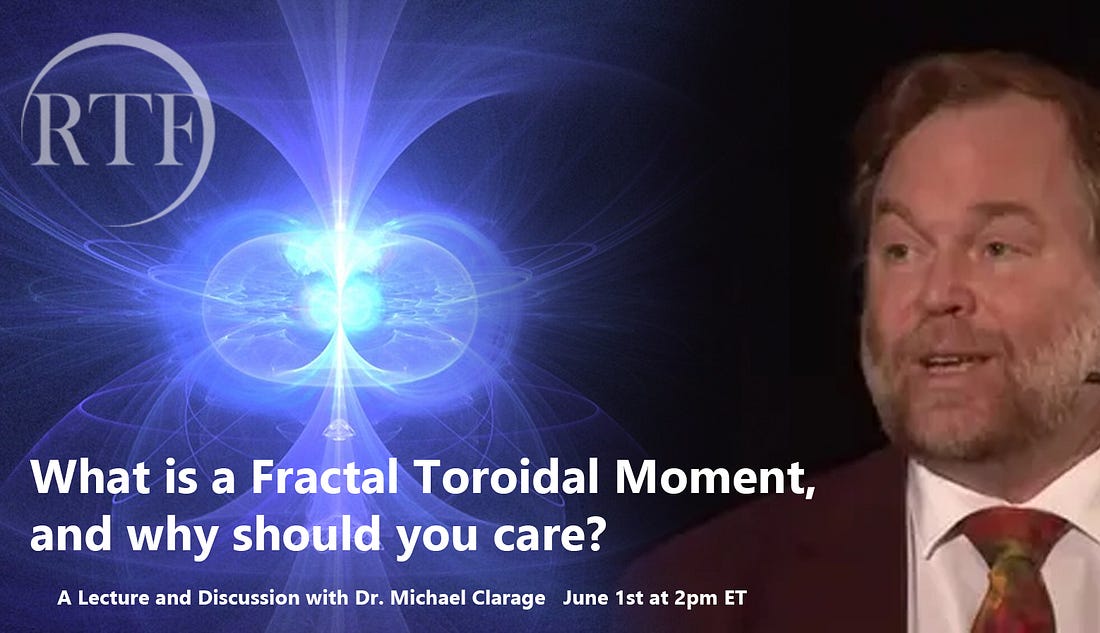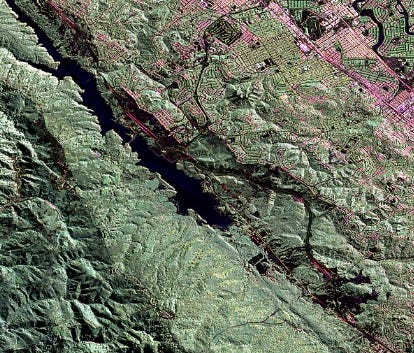|
Saturday, 31 May 2025
You teach people how to treat you.
RTF invitation: What is a Fractal Toroidal Moment, and why should you care?
RTF invitation: What is a Fractal Toroidal Moment, and why should you care?Featuring Michael Clarage on June 1st at 2pm ET
This Sunday June 1st at 2pm Eastern Time, I am happy to announce that Dr. Michael Clarage will be delivering a presentation on Fractal Toroidal geometries, and the non-Euclidean geometries needed to make discoveries of our electric universe and densely saturated, and highly dynamic physical space time. If you are thinking that this topic isn’t political and thus not interesting, you are incorrect. Speaker bio: Dr Michael Clarage received his PhD in physics from Brandeis University in 1992, studying the biological and statistical behavior of proteins. Prior to that, he spent several years studying binary pulsars at the Arecibo radio telescope. He has given traveling lectures in the areas of fractional calculus, fractals, and chaotic systems as well as presented public talks on such topics as relativity and dimensions, transformation in supernova and metamorphosis in biology. Dr. Clarage is currently a scientist with the SAFIRE Project and curates a blog on Substack. His previous RTF lecture The Light of Life can be watched here The presentation Dr. Clarage will deliver will be inspired by (but not limited to) a series he recently published titled ‘Fractal Torus’ parts 1-4 available here: Fractal Torus 4 - Grain of Salt Fractal Torus 3 - A Naturally Arising Structure? Fractal Torus 2 - Self Sustaining Fractal Toroids - Part 1, Geometry Click below to access the live event on Zoom on Sunday June 1st at 2pm ET/11am PST/8pm Berlin Time:... Subscribe to Rising Tide Foundation to unlock the rest.Become a paying subscriber of Rising Tide Foundation to get access to this post and other subscriber-only content. A subscription gets you:
© 2025 Rising Tide Foundation |
Friday, 30 May 2025
Grief's Fault
Writing is such an intimate and simultaneously expansive exercise. It’s as immediate as the moment and as timeless as forever. I recently revisited an essay on grief I wrote about three years ago, three years after my son Elliot died. I was profoundly honored when my dear friend and spiritual guide, Fran Shelton, asked to include it in her wonderful book, The Spirituality of Grief: Ten Practices for Those Left Behind. The version in the book was poignant and universal, but when I revisited the piece, I realized the editors had removed references I made to COVID. What memories that ignited, reminding me of how the confinement and anguish of the pandemic must have intensified what was already overwhelming grief. I’m not sure I realized it at the time, and I don’t think that we as a country have fully processed the massive trauma of that prolonged ordeal. These words still resonate today. The grief will always be part of me, just as Elliot will be, but thankfully, the bitter is now allowing glimpses of sweet. Here is the original essay: I don't live in the wilderness. The wilderness lives in me. It's not out there. It's inside me. That's what makes living so hard. The problem is grief is so disorienting and isolating — the disconnection from people, places, and purpose. Grief clouds your mind’s eye and scuttles your sense of possibility. Nothing feels right, and neither do you. So many directions, but no place to go. It’s an unrelenting bewilderment — figuratively and physically, together and apart, curious and terrifying. How could this possibly have happened? Historically, ambiguity has never bothered me much, but now, waist-deep in the viscous stew of the post-Elliot present, I’m finding it profoundly difficult to figure out where I am in the wilderness. There is no effective grief nav, and this is no ordinary time. But there is no denying the line in the sand. I call it grief’s fault — the deep crevasse traversing the landscape of my psyche, forever dividing the time before Elliot’s death from the time after, seething with the tension of an impending tectonic rupture. It defines two separate lives, two completely different identities — joined by a precarious fracture. And three years into my “after,” I’m still brittle, directionless, and detached from most everything, except this piercing pain in my shattered heart. At least, the icepick quality has morphed into a constant, dull ache. The anguish of this kind of grief never goes away. It just mutates, kind of like the Coronavirus. But I have to believe both will subside in time. I exist in some sort of distorted meantime, like the Twilight Zone, between the before and the next, the shadow and the light. So difficult to navigate. Erratic directives from the Centers for Disease Control, my surviving son Ian’s bout with COVID, and the chaos of sequestering, masking, and isolating (particularly in the non-compliant state of Texas) is exhausting. The other problem is that the edges of my life have shrunk into the circumference of a tiny private island — and not the good kind. Having spun myself into a tight emotional cocoon with the steely threads of grief, anxiety, and CPTSD, I question everything, including my professional choices, yet I made some doozies before Elliot’s death. They say you shouldn’t make any big decisions after a major loss, but does that apply to the rest of your life? And as a single, seasoned, anxious mom, I have to make a living and function. It’s a cruel conundrum. I recently read somewhere that a consistent physical manifestation of grief across cultures is the expansion of the amygdala, the minuscule part of the brain that regulates emotions. In grief, it can grow and disrupt the frontal cortex, which is responsible for logical decision-making. I figure my amygdala must be the size of a cantaloupe. Though I am fully vaccinated and boosted, I just can’t seem to get beyond the pandemic mindset and the paralyzing, pervasive fear of engaging in the world. My greatest sense of accomplishment typically comes from completing a trip to Target. At least, I am not washing my cereal boxes anymore. Thriving has become irrelevant. So, how do I make sense of such a predicament in this phase of life and this stage of grief, though I don’t buy into the Kübler-Ross stages concept? How do I find a safe place to hang on when the next seismic shift rattles me to the core? Pastors say, “Be gentle with yourself.” That has always been a challenge for me, but I am noticing that grief is gradually teaching me to take better care of myself through this worst of all possible times. To re-parent Elaine in a way. So, this I know — for Elliot’s death, for Ian’s life, and for my fragile soul, I want to figure out a way to live through this unbearable now. Flicker Sitting still in the deep alone—where I am Is there a place to be? If I leave space, there is nothing real to touch, to know, to attach to anything but grasping for fleeting flickers of the present tense, shining light on eternity and the meaning I find only in writing my ache, pulling the thread through my heart’s break To see the truth of now Grief Matters is a reader-supported publication. To receive new posts and support my work, consider becoming a free or paid subscriber. You're currently a free subscriber to Grief Matters. For the full experience, upgrade your subscription. © 2025 Elaine Gantz Wright |
August reset! Destination dupes, delicious recipes and a wellness retreat that may be the start of a new you!
Get your weekly dose of lifestyle reading. ...





